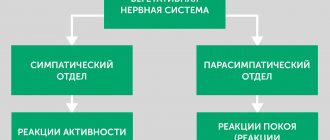Panic attacks in children are a relatively rare phenomenon, occurring in no more than 3% of patients in the general population. The disease is severe, the child suffers from unmotivated attacks of fear and internal anxiety. This creates interference in learning and is met with misunderstanding from peers, which can result in bullying. The symptoms frighten the child and parents and force them to actively look for ways to solve the problem. The search does not always lead people to the right place, i.e. the psychiatrist's office. Parents often turn to all sorts of charlatans: “traditional healers,” psychics, priests, etc., even exorcists. Needless to say, such therapy does not benefit the baby, and the lack of results only aggravates the stress.
To combat the manifestations of panic syndrome successfully, you need to stop taking it for something supernatural. Although this is a rare, but well-studied medical problem.
What you need to know.
- Panic attacks occur mainly in schoolchildren after 7-10 years of age.
- Children who have entered adolescence are automatically at risk, since their hormonal levels change significantly.
- The occurrence of the disease is impossible to predict and difficult to prevent. All that parents can do is to prevent the baby from overtiring and, if possible, reduce the stress on his psyche.
Signs of a panic attack
A panic attack can be motivated or unmotivated. A motivated attack is caused by a real source of fear, for example, a child may react in this way to a scene of domestic violence, an animal attack, etc. This reaction is normal, it is one-time and does not require any special treatment. Show your child to a psychologist so that severe fright does not develop into psychological trauma, that’s all you need. An unmotivated attack is a sign of pathology.
An attack of unmotivated fear can occur in any situation, even when the child is not in danger and is not scared. If this happens, you must consult a doctor immediately.
Symptoms and first signs of panic attacks in teenagers:
- varying degrees of anxiety: from causeless excitement to complete panic;
- dyspnea;
- tremor of the limbs;
- numbness of the body;
- dysfunction of digestion and urination;
- nausea and vomiting;
- dizziness;
- frequency of attacks.
Sometimes an exacerbation of the syndrome can be caused by intercostal neuralgia. During such attacks, breathing becomes difficult, which can be very frightening for a teenager. But in childhood this disease is rare.
Is it possible to outgrow PA?
Some dads and moms hope that a panic attack, like a hysteria, will simply go away on its own with age. But doctors warn: if PA is not treated, it will develop into panic disorder, mental illness, and will interfere with the teenager’s ability to socialize, build relationships or a career.
That is why parents need to know the symptoms of PA in their child:
- rapid heartbeat and frequent shallow breathing;
- pale skin;
- perspiration on the palms, back;
- complaints of nausea, stomach cramps;
- tremor of the limbs;
- headache or dizziness.
These symptoms indicate problems with the autonomic part of the nervous system and require qualified therapy.
Reasons for appearance
There are three types of causes of illness: biological, psychological and genetic. The first include diseases of the internal organs, the symptom of which may be panic syndrome. Most often, this is a malfunction of the adrenal glands, leading to uncontrolled excess releases of catecholamines and general hormonal imbalance. A biological predisposition to a disease is possible, the activation of which requires an external factor: stress, psychological trauma, stressful life circumstances.
The psychological causes of panic attacks in teenagers are all kinds of personality disorders, excessive stress, pressure from parents and teachers, bullying from peers, problems of the transition period, etc. Morbidity rates are rising among children from disadvantaged families. Psychological reasons include the following factors:
- violence in family;
- alcoholism, drug addiction, reduced social responsibility of parents;
- authoritarian education.
Genetic causes are bad heredity. The risk of morbidity increases by an average of 17% in the presence of first-degree relatives who have previously experienced attacks. However, the genetic factor may or may not appear, so the causes of morbidity are best considered in their entirety.
The psychological factor often acts as a trigger, activating other predispositions of the body. Without it, the disease may never arise, even if all other prerequisites for its development exist.
PsyAndNeuro.ru
Over the past ten years, several meta-analyses have been published summarizing the current knowledge of the treatment of anxiety disorders in children and adolescents, tolerability, predictors and moderators of treatment outcome, and risk factors.
RCTs published during the 10 years up to July 2021 on anxiety disorders in children and adolescents were selected for this review. Studies that used DSM-4 diagnostic categories classified PTSD as an anxiety disorder and did not always include separation anxiety disorder.
Anxiety disorders begin earlier than all other childhood mental illnesses, with a median age of onset of 6 years (depression 13 years, substance abuse disorders 15 years).
Specific phobias
Specific phobias are anxiety disorders that begin at a very early age (the average median age of onset is 6 years).
Separation anxiety disorder
The average age of onset of the disease is 8 years. In the United States, separation anxiety disorder occurs in 6.7% of children (more often in girls than boys). Separation anxiety disorder increases the risk of developing panic disorder later in life (hazard ratio, 3.5) and significantly increases the risk of generalized anxiety disorder (hazard ratio, 7.7).
Social anxiety disorder (SAD)
Behavioral inhibition is common in children with social anxiety disorder. The full onset of anxiety disorder symptoms occurs around age 12. Social anxiety disorder, which affects about 9% of adolescents, is associated with an increased risk of developing other anxiety disorders and school failure.
Generalized anxiety disorder (GAD)
As with most anxiety disorders, female gender increases the risk of GAD in post-puberty. Between the ages of 13 and 18, GAD occurs in 2.2% of adolescents.
Panic disorder (PD)
Panic disorder is the “last” childhood anxiety disorder in terms of developmental chronology. The incidence, as in the case of social anxiety disorder and GAD, increases in older age groups: 1.8% at the age of 13-14, 2.3% at the age of 15-16, 3.3% at the age of 17-18.
Agoraphobia
At the age of 13-17 it occurs in 2.5%.
The proportion of patients with severe anxiety (severe functional impairment or very severe distress) varies depending on diagnosis. Severe forms of PD, SAD, and GAD are more common in older children, affecting 8.3% of adolescents. Most adolescents with PD or agoraphobia experience severe anxiety; in the group of adolescents with GAD, severe anxiety occurs in half of the patients. In SAD, severe anxiety occurs in 14.3% of cases. In case of separation anxiety disorder, severe form of anxiety is observed in 7.9%, in case of specific phobias - <5%.
At present, it remains unclear how the combination of known environmental, biological, and developmental factors leads to anxiety disorders.
Cognitive risk factors
Cognitive risk factors for anxiety disorders include cognitive distortions associated with threat response, intolerance of uncertainty, and learned behavior (e.g., avoidance). Avoiding situations that provoke anxiety in a child or adolescent operates on the principle of negative reinforcement. Intolerance to uncertainty manifests itself in the tendency to react negatively (at the emotional, cognitive, behavioral level) to a state of uncertainty.
Behavioral inhibition as a risk factor
Behavioral inhibition - a feeling of depression that occurs when interacting with unfamiliar people or in unfamiliar circumstances - is observed in 15% of children and increases the risk of anxiety disorders (GAD, SAD, BD and separation anxiety disorder). Some studies, including meta-analyses, suggest that behavioral inhibition increases the risk of SAD the most (by a factor of 7); Almost half of children with behavioral inhibition develop SAD, and the risk does not depend on temperament or age. Certain aspects of behavioral inhibition—fear of adults—may be associated with the risk of separation anxiety disorder.
Family situation as a risk factor
Having a parent with GAD, parental separation, and a dysfunctional family (as measured by the McMaster Family Functioning Scale) significantly increases the risk of developing GAD. Events associated with separation from parents further increase the risk of anxiety disorders.
There is conflicting evidence regarding the influence of parental behavior. Some studies show that overprotective parenting increases the risk of anxiety. On the other hand, there are studies showing that the main influence on the risk of anxiety disorders is exerted by specific types of parental behavior that contribute to the formation of learned behavior patterns in the child. The EDSP program (“Early Stages of Psychopathology” - a prospective longitudinal study started in 1994 in Munich) did not reveal a link between excessive parental care and an increased risk of anxiety disorders. The parental model of anxious behavior contributes to the fact that children avoid new situations or treat them with increased caution.
Parental Anxiety Disorders
An anxiety disorder or certain personality disorders in a parent increases the risk of an anxiety disorder in a child. For example, parental GAD increases the risk of developing childhood GAD but does not affect the risk of depressive disorders. However, if a parent has an anxiety disorder as well as a depressive disorder, the child has an increased risk of an anxiety disorder, but without an increased risk of depression. In children of parents with symptoms of personality disorders of clusters A and C, symptoms of anxiety are more pronounced.
Substance use and risk of anxiety disorders
As with other risk factors, the association of substance use with the pathogenesis of anxiety disorders is difficult to judge from cross-sectional and prospective studies. There is evidence that alcohol use increases the severity of panic disorder symptoms in adolescents. In the group of older teenagers, the connection between panic attacks and the desire to drink alcohol is not confirmed, from which we can conclude that the hypothesis explaining the use of alcohol by adolescents to reduce panic attacks is weak.
In recent years, the connection between cannabis use and anxiety disorders has become clearer. Daily cannabis use during adolescence increases the risk of developing anxiety disorders even among those who have stopped using, which likely suggests long-term effects of cannabis on adolescent mental health. The use of synthetic cannabinoids is associated with a decrease in gray matter volume and changes in the activity of cortical structures involved in the pathophysiology of anxiety disorders. It remains unclear whether the use of other cannabinoids has the same effect and which specific psychoactive component is responsible.
Environmental pollution as a risk factor
Relatively few studies have focused on the effects of environmental pollution, particularly air pollution. Mercury and other toxic substances increase the risk of developing anxiety disorders. Increased concentrations of mercury in the mother's body at the time of birth increases the likelihood of a child being diagnosed with anxiety disorders at the age of 8 years. Vehicle pollution has also been linked to increased anxiety symptoms.
Compared to other groups of drugs, antidepressants have been studied best and have also shown the best effectiveness. The anti-anxiety effects of antidepressants support the recent shift in psychopharmacology from diagnosis-based terminology, often tied to the drug's first application, to NbN nomenclature based on mechanism of action and pharmacology.
SSRIs
SSRIs are most effective in treating childhood and adolescent anxiety disorders, but patients taking SSRIs discontinue treatment due to side effects more often than patients taking SSRIs. In addition, SSRIs are more likely than SSRIs to produce an stimulating effect in children and adolescents.
In the United States, SSRIs are most commonly prescribed for the treatment of anxiety disorders in children and adolescents. In approximately half of cases, treatment lasts at least 6 months. It is worth noting that nearly one in three non-adult patients with anxiety in the United States are treated with a non-SSRI drug.
Studies of the effect of SSRIs in child psychiatry in the treatment of anxiety disorders show that in 70% of those cases where improvement is recorded in the 8th week of treatment, it occurred earlier - within the first 4 weeks. Compared with SSRIs, improvement occurs more quickly, with trajectories of improvement diverging between SSRIs and SSRIs around the 4th week.
A meta-analysis on side effects showed that SSRIs are often interrupted due to side effects, which include agitation, sedation, insomnia, abdominal pain, and headache. Neither SSRIs nor SSRIs are associated with suicidality requiring emergency intervention. In the SSRI group, the meta-analysis found a difference in the risk of suicidality. The safest in this regard is sertraline.
SSRI
Two studies showed the effectiveness of venlafaxine in the treatment of GAD, one - in the treatment of SAD. One study showed the effectiveness of duloxetine in the treatment of GAD, and one study showed the effectiveness of atomoxetine in the treatment of ADHD with comorbid anxiety disorders.
TCA
Due to relatively poor tolerability, TCAs have given way to SSRIs and SSRIs. There is limited research on their effectiveness in treating anxiety disorders in children. A study showing the effectiveness of imipramine in the treatment of SAD was published quite a long time ago - in 1971.
Modulators 5-HT1A
Two 2021 studies showed no difference between the effects of buspirone and placebo in the treatment of GAD in a group of patients 6-17 years of age.
Alpha adrenergic agonists
A small 2021 study found that guanfacine was no different in treating anxiety disorders than placebo on the PARS (Pediatric Anxiety Rating Scale) and superior to placebo on the Clinical Global Impressions Scale (CGI-I). patient's condition).
Benzodiazepines
There is evidence supporting the use of benzodiazepines in the acute treatment of anxiety in children and adolescents, but studies of long-term use of benzodiazepines for the treatment of anxiety disorders in non-adults suggest no benefit. With regard to emergency suicidality, the risk of benzodiazepines in the treatment of anxiety disorders in children and adolescents was demonstrated in a 2021 meta-analysis. However, the results of this meta-analysis depend significantly on one small RCT from 1994, so there remains a need for more research.
Several recent studies in child psychiatry have shown that benzodiazepines as an adjunct to primary treatment—at least for treatment-resistant depression—impair treatment tolerance and presumably increase the risk of suicidal events (suicidal ideation, self-harm, suicide attempts).
Combination of SSRIs with psychotherapy
For the treatment of anxiety disorders in child psychiatry, experts recommend a combination of SSRIs + psychotherapy (CBT). However, the effectiveness of this combination has been studied in relatively few studies.
The largest study of the effectiveness of SSRIs in the treatment of anxiety in children, CAMS (“Child/Adolescent Multimodal Anxiety Study,” 2008), showed that the combination of CBT + sertraline was more effective than psychotherapy or sertraline alone.
More than 20 RCTs suggest the benefits of CBT in treating childhood anxiety disorders. Recommendations of CBT as a first-line treatment are based on the accumulated evidence of effectiveness, the limited nature of side effects, and the willingness of the patient and his family to psychosocial therapy. It is important to remember that there is a gap between the conditions in which psychotherapy is practiced during research and the conditions in everyday life. In particular, this concerns adherence to treatment in the form of exposure therapy - this component is better in research groups than in clinical practice.
Author of the translation: Filippov D.S.
Source: Strawn, JR, Lu, L., Peris, T.S., Levine, A. and Walkup, J.T. (2020), Research Review: Pediatric anxiety disorders – what have we learned in the last 10 years? Journal of Child Psychology and Psychiatry
Consequences of panic attacks in children and adolescents
An attack can overtake a person at any time, for example, in a potentially life-threatening environment, in a public place, during an important event, etc. This gives rise to another mental disorder - anticipation syndrome. The child is afraid that an attack is about to happen, and is constantly waiting for it. Many patients are afraid to leave the house and, as a result, cannot live a full life. This is especially dangerous for a child, because he is at the stage of intensive physical and psycho-emotional development, must move a lot, communicate a lot, and constantly gain knowledge and experience. Turning him into a recluse at this period of life is disastrous.
Panic attacks in teenagers are perceived especially acutely by them themselves, when they are so full of problems against the backdrop of a strong hormonal surge. He begins to feel almost disabled at a time when it is very important to prove himself, take his place in society, and learn to communicate with the opposite sex.
What happens to the child?
During a panic attack, something like this happens in the human body:
- A sharp surge of adrenaline.
- The consequence is vasoconstriction, increased breathing and heart rate.
- Increased blood pressure.
- Rapid breathing increases the release of carbon dioxide, which further increases anxiety.
- Carbon dioxide changes the pH of the blood. This leads to dizziness and numbness of the limbs.
- Vasospasm slows down the delivery of oxygen to the tissues: lactic acid accumulates, increasing the manifestation of the attack.
Treatment
Treatment of panic attacks can give positive results in a short period of time if you consult a doctor in a timely manner, after the first incident. That is why it is necessary to monitor the teenager, monitor changes in his usual behavior and promptly fight to preserve the child’s mental health.
This problem can be successfully treated, but you need to achieve this not on your own, but strictly in tandem with a specialist who will study the problem of panic, the prerequisites for its occurrence, and prescribe appropriate therapy.
Most often, specialists prescribe the following groups of drugs:
- anticholinergics;
- neuroleptics;
- tranquilizers;
- ganglion blockers;
- nootropics;
- vascular agents;
- desensitizing drugs.
There are contraindications, you need to consult a specialist!
Related posts:
- Anonymity in psychiatry Psychiatry is a branch of medicine whose activities are aimed at studying the causes...
- Features of the course of schizophrenia in older people Schizophrenia is a mysterious, terrible disease. In the minds of the general public...
- The body's response to the cause of acute stress Acute stress reaction is a transient disorder of significant severity that...
- Obsessive-compulsive disorder (OCD): symptoms and treatment A mental illness manifested in the presence of obsessive ideas, thoughts, actions,…
Medication and psychological assistance
The psychologist explains how to behave during attacks, how to prevent them, and teaches relaxation skills. Sessions are scheduled if necessary. During the sessions, a calm perception of emerging life problems is formed, a change in attitude towards oneself and people.
The optimal way to treat PA is considered to be a combination of work with a specialist and medications. The drugs should help stop PA. These include, for example, benzodiazepines. However, with constant use of these drugs, drowsiness and fatigue occur, which adversely affects the learning process.
There are contraindications, you need to consult a specialist!
First aid
First of all, during an attack, you need to calm down and begin to think that a panic attack does not pose a health hazard. No one has ever died from this.
You need to learn to control your breathing while breathing evenly and elongated. It helps to start counting or considering what is around.
If a loved one is nearby during an attack, then you need to take him by the hand and talk.
You must try to completely relax and think about good things. If you feel hot, you need to wash with cold water. If it’s cold, you can drink tea or take a warm shower.










